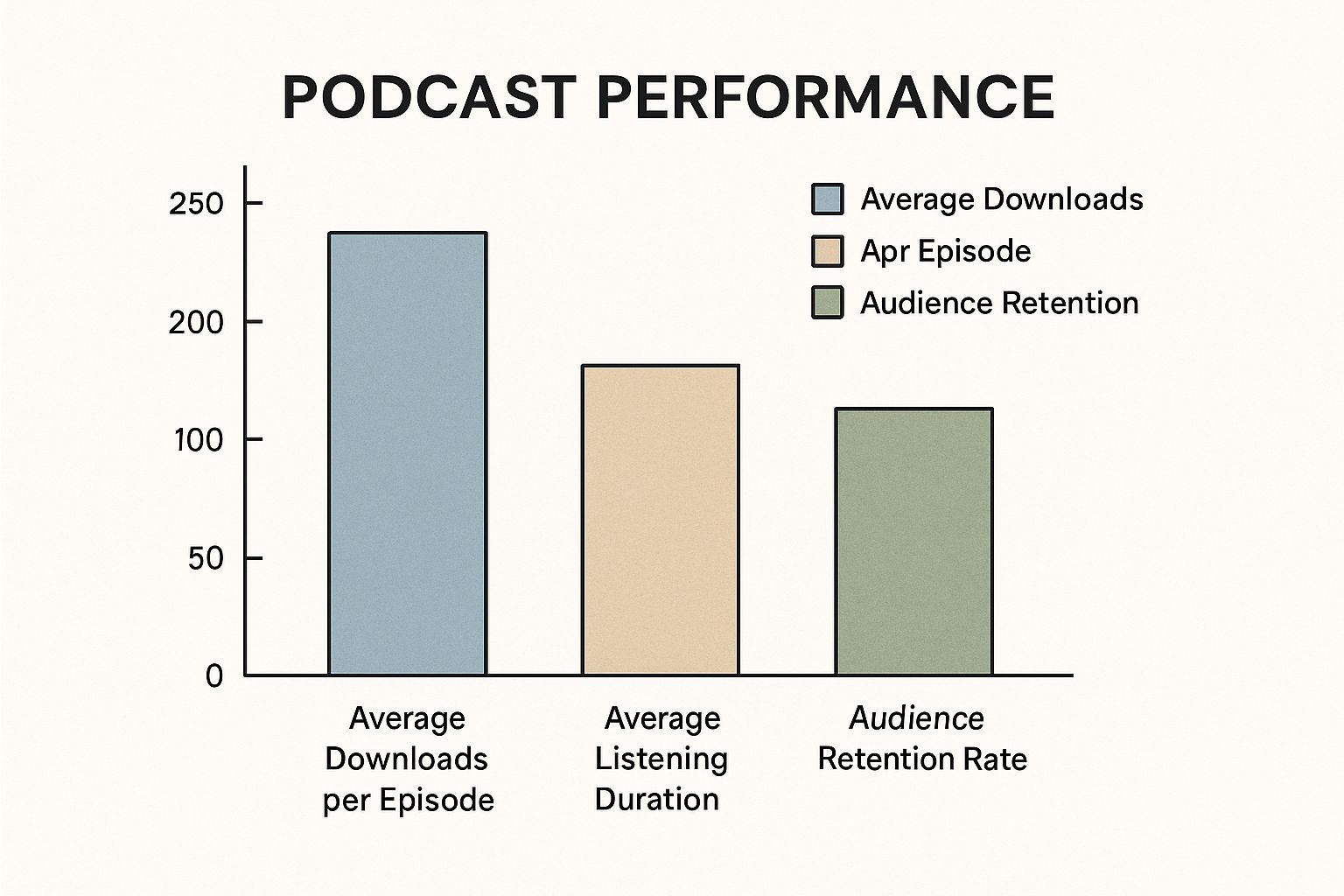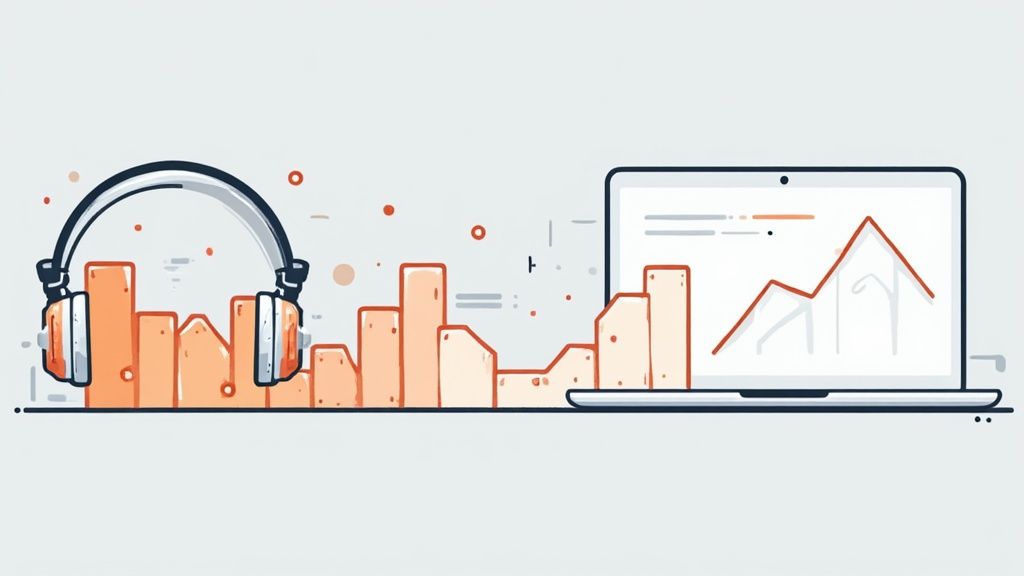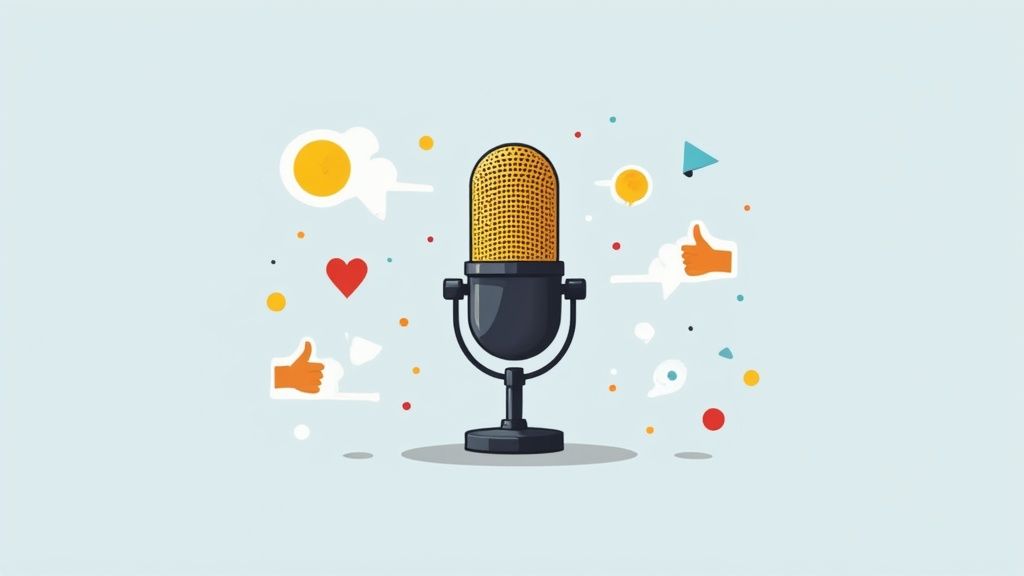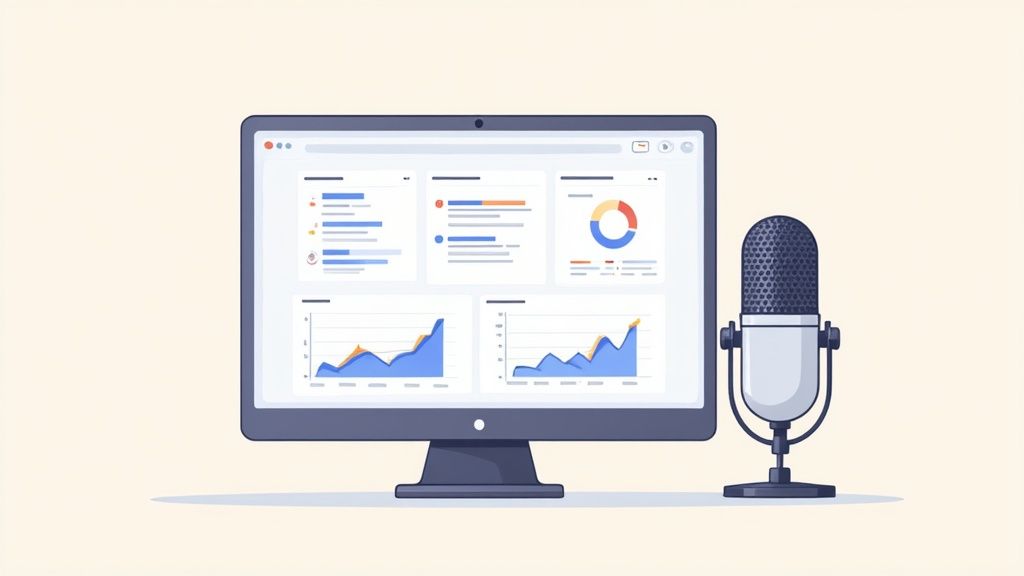Sick of staring at your download numbers and wondering if your B2B podcast is actually working? You’re not alone. For too long, podcasters have been obsessed with that one vanity metric. But a big download number doesn't tell you much, especially in B2B. As our founder, Tom Hunt, often says, a small, die-hard audience of ideal customers is far more valuable than a massive, passive one.
The way we think about podcast performance has finally caught up. It’s no longer just about counting downloads. It's about digging into the data to understand who is listening, how much they care, and what they do after an episode ends. This is how you connect your podcast directly to real business goals.
The Four Pillars of Modern Podcast Measurement
So, how do you get the full picture? I find it helps to organize metrics into four core areas. This isn’t just about creating a pretty report card; it’s a strategic framework that helps you see what’s working, spot weaknesses, and make smarter decisions for your show.
To give you a comprehensive view of your podcast's success beyond just download counts, we can break down the key areas to track. This approach shifts the focus from simple numbers to actionable insights.
Thinking in these four pillars turns measurement from a reactive task into a proactive tool for growth. It also helps you see where you stand in the bigger picture.
It's a huge market out there. The global podcast audience has swelled to around 584.1 million listeners, and it’s growing every year. In the U.S., a staggering 55% of people aged 12 and up listen to podcasts monthly. Tracking your own growth against these kinds of numbers gives you some much-needed context.
This chart drives the point home perfectly:

As you can see, sky-high downloads don't automatically mean high engagement. The real magic happens when you build a show that performs well across all four pillars. You're not just building an audience; you're building a powerful business asset.
For a deeper dive into how these efforts can stack, check out our guide on how to measure podcast PR effectiveness.
Tracking Audience Growth and Reach That Converts
Foundational numbers are great for seeing your podcast's initial appeal and reach. And sure, seeing a huge total download number feels good, but the real story—the one that actually matters for growth—is buried in the details.
We need to look past those vanity metrics and focus on what truly signals a healthy, growing show and whether your marketing is actually working.

This means shifting your attention to more specific figures. It's not just about how many people download, but who they are and how consistently you’re pulling them in. These numbers are your first real clue about what’s clicking with your target audience.
Moving Beyond Simple Downloads
To get a clear picture of your show's magnetic pull, you have to concentrate on a few key growth indicators. Each one tells a different part of the story, from how people first find you to whether they become loyal fans.
Here’s what I'd recommend tracking:
- Unique Listeners: This tells you how many individual people downloaded your show in a set period. It's a far more honest measure of your true audience size than total downloads, which can get bloated by one superfan downloading every single episode.
- Downloads Per Episode (First 30 Days): This is the industry-standard yardstick for comparing how your episodes perform against each other. Tracking this helps you spot patterns. Did that interview with a particular guest blow up? Did a deep dive on a niche topic get way more downloads than usual? That's your signal to double down on what works.
- Subscriber Growth Rate: Subscribers are your ride-or-dies. They’re the ones who want to know the second a new episode drops. A steady climb in this number is a core sign of a healthy podcast and shows you're building a real community.
The magic happens when you analyze these trends over time. Are you seeing consistent growth, or have you hit a plateau? Did you see a big spike after that last marketing push? This is how you refine your content and promotion strategy. For a more complete picture, you can dig into the most important podcast success metrics that really move the needle.
Key Takeaway: Consistent growth in unique listeners and subscribers is a much stronger signal of success than a one-off viral episode. The goal is to build a stable, engaged audience that sticks around.
Aligning Audience with Your Ideal Customer
For any B2B podcast, a huge audience is nice, but reaching the right audience is everything. Your hosting platform can give you some great demographic data—like age and location—that helps you check if your listeners actually line up with your ideal customer profile (ICP).
But here’s the thing: attracting and keeping those perfect listeners starts with one non-negotiable—impeccable quality. It doesn't matter how brilliant your content is if the audio is terrible. No one will stick around.
That’s why top-tier recording is so critical. Using a platform like Riverside.fm, an excellent tool for capturing studio-quality remote recordings, is a game-changer. It’s that commitment to quality that convinces a casual listener to hit "subscribe" and keeps them coming back.
Gauging True Audience Engagement and Loyalty
An audience on its own doesn't mean much if no one is actually listening. While growth metrics tell you how many people you’re reaching, engagement metrics reveal how deeply they connect with your content. This is where you find out if you're building a loyal community or just shouting into the void.

The first place I always look is the average consumption rate, which you might also see called the "drop-off rate." This is a vital sign. It shows you exactly how much of an episode people are sticking around for before they tune out.
Analyzing this data across your episodes provides invaluable feedback. If you consistently see a major drop-off at the 15-minute mark, it might be time to seriously re-evaluate that segment or just tighten up your episode structure.
Look Beyond The Analytics Dashboard
While the quantitative data is crucial, the qualitative signs of engagement are often far more telling. These are the human signals that prove you're building a real connection, not just broadcasting to a faceless audience.
Look for these signs:
- Reviews and Ratings: This is direct feedback on platforms like Apple Podcasts. More than just an ego boost, positive reviews are the social proof that helps attract new listeners.
- Social Media Comments and Shares: When someone takes the time to comment on your episode post or, even better, share it with their network, that's a strong endorsement.
- Direct Emails and Messages: Listeners who reach out directly are your most engaged fans. Their questions and feedback are pure gold for future content ideas.
These interactions are the bedrock of any successful B2B podcast. They're what transform casual listeners into dedicated advocates for your brand. Promoting your show is key to sparking these conversations, and our guide on how to promote a podcast for B2B growth offers some solid, actionable strategies.
Key Insight: True loyalty isn't measured in downloads; it's measured in actions. A listener who shares your episode is more valuable than a hundred who listen silently and disappear.
Understanding Listening Intensity
Diving a little deeper, you can measure performance by looking at how intensely people listen. YouGov's recent data covering 49 global markets found that 41% of consumers listen to podcasts for at least one hour per week. This shows that engagement duration is a seriously significant metric.
For a broader understanding of how this kind of data can inform audience interaction and loyalty, you might want to explore resources on measuring audience engagement through analytics. Getting a handle on these habits helps you see the true commitment of your audience, which is a key part of the puzzle when you measure podcast performance.
Linking Your Podcast to Tangible Business Results
For any B2B brand, this is the moment of truth. Audience and engagement metrics are great for showing you're building a following, but tying your podcast directly to business results? That's how you prove its real worth.
It’s how you shift the conversation from, "How many people listened?" to, "How much business did we actually drive?"
The most straightforward way to start is by tracking website traffic. You can create unique, memorable URLs or use UTM codes in your show notes for any link you mention. This gives you a clear attribution path, showing you exactly how many listeners were motivated enough by your content to visit your site.
Attributing Leads and Revenue
The next level up is tracking conversions from that traffic. A common tactic I've seen work incredibly well is creating a dedicated landing page just for your podcast audience.
Think something simple, like yourcompany.com/podcast.
You can then mention this link in your episodes whenever you offer a resource, a demo, or a newsletter sign-up. This one simple step creates a clean, undeniable channel for attribution. When a lead comes through that specific page, you know with near-certainty that your podcast was the source. This is how you start connecting your audio content directly to your sales pipeline and revenue.
For a real-world example of how strategic development and insightful measurement can lead to significant growth, consider exploring how Tran Dev ignited Actpods' rise to podcasting revolution.
The Relationship-Building Engine
But let's be honest, not all value can be tracked with a UTM code. As our founder, Tom Hunt, often points out, B2B podcasting is a powerful relationship-building engine. Often, the most significant ROI comes from the connections you build—both with guests and listeners.
Tom's own activity is a perfect example of how a podcast becomes a central hub for industry networking and thought leadership. These relationships often lead to the most valuable, albeit "hard-to-measure," outcomes.
A guest on your show might become a strategic partner six months down the line. A listener from a company you've never heard of could reach out and become a high-value, long-term client. These are the wins that rarely show up on an analytics dashboard but are direct results of your podcasting efforts.
Tracking Financial Growth and Market Context
Understanding your podcast's financial context is also key. The podcasting market is seeing explosive growth, with ad spend rocketing toward $4.46 billion and the entire market projected to hit a staggering $204.75 billion by 2033.
This growth isn't happening in a vacuum; it's fueled by the convenience of on-demand audio and a massive diversity of creators. Tying your own show's performance to these industry trends helps justify investment and optimize your strategy. You can read more about these podcast market forecasts to get a better sense of the landscape.
Ultimately, tracking these business results is fundamental. But to have results to track, you first need a growing audience. For actionable strategies on that front, explore our guide on how to get more podcast listeners with top growth tips.
Measuring and Amplifying Your Brand's Influence
A great B2B podcast does way more than just fill your pipeline with leads. Its real power, something that's often overlooked, is in cementing your brand as an undeniable authority in your space. To really get a handle on this, you have to look beyond your basic hosting analytics and watch how your brand's presence shifts across the entire industry.

This change in perception—from just another company to the company—is a crucial part of measuring your podcast's performance. When your show starts to click, you'll see ripple effects in ways that are both subtle and impossible to ignore.
Tracking Signals of Growing Authority
So, where do you start looking? Your brand's digital footprint is the first place. You need to keep an eye on the conversations happening outside your direct control, because that's where the magic really happens. These are the strongest signs of your growing influence.
Here are the key signals I always tell people to track:
- Brand Mentions: Are other creators, influencers, or even competitors talking about your podcast on social media without you prompting them? These organic shout-outs are a real-time barometer of your show's reputation. You'll need social listening tools to catch them all.
- Inbound Links: Is your website picking up more backlinks? Look for links from guest show notes, industry blogs, or news articles that reference your content. A steady climb in high-quality inbound links is a tangible sign that you're becoming a go-to source.
- Guest Appearances: This is a big one. Are you or your host getting invited to appear on other industry podcasts? Every single invitation is a third-party endorsement of your expertise, and it pushes your brand out to new, highly relevant audiences.
But perhaps the most telling sign of your show's rising status is the quality of guests you can land. As your podcast's reputation grows, you'll find it's suddenly much easier to book interviews with sought-after experts and high-profile leaders. It’s a powerful metric on its own and creates a fantastic virtuous cycle: great guests pull in a bigger audience, which then helps you book even better guests.
Key Takeaway: Brand influence isn't just a warm, fuzzy feeling; it's a measurable outcome. Track your mentions, inbound links, and guest invitations to put real numbers behind your podcast's impact on your industry standing.
Amplifying Your Influence Systematically
Once you've got some momentum, you can't just sit back. You have to amplify it. This means you need a system to make sure your thought leadership is hitting the right people and creating a measurable brand lift across all your channels. This is where smart content distribution comes into play.
By repurposing your podcast, you can spin a single episode into a full-blown, multi-channel brand-building campaign. This is where a specialized agency excels. A B2B Social Media Agency can repurpose episode highlights into engaging social posts and video clips, while a B2B Email Newsletter Agency can craft compelling summaries that drive traffic and reinforce your authority with your subscribers.
A systematic approach like this ensures your influence isn't just passively growing—it's being actively multiplied. To get a complete picture of what you should be looking at, you can explore the 10 B2B podcast metrics you need to track and build out a truly holistic measurement plan.
Your Top Podcast Measurement & Promotion Questions Answered
Even with a solid framework, questions always pop up when you get into the weeds of measuring and promoting your podcast. Let's tackle some of the most common ones we hear from B2B brands trying to connect their show to real, strategic growth.
What are the benefits of investing in B2B podcast promotion?
Investing in promotion is what turns your podcast from a passive piece of content into an active business asset. You can have the best show in the world, but if nobody knows it exists, it’s just talking into the void. Without promotion, you rely on slow organic discovery. With it, you gain significant benefits:
- Accelerated Audience Growth: Promotion puts your podcast directly in front of your ideal customer profile (ICP), drastically shortening the time it takes to build a relevant audience.
- Enhanced Brand Visibility and Authority: Strategic promotion doesn't just get you downloads; it places your brand at the center of key industry conversations, boosting your company's profile and cementing your status as a thought leader.
- Direct Lead Generation: By driving the right kind of traffic to your website through targeted calls-to-action, promotion creates a direct bridge between your content and your sales pipeline.
- Improved ROI on Content Creation: Promotion ensures the significant time and resources you invest in creating high-quality episodes actually deliver a measurable return.
What are effective B2B podcast promotion strategies?
Effective B2B promotion is about precision, not just volume. You need to reach the right people where they are already active and engaged. The most effective strategies for corporate podcasts include:
- Systematic Guest Amplification: Tap into your guest's network by making it effortless for them to share. Provide pre-made, high-quality assets like audiograms, video clips, and quote graphics.
- Multi-Channel Content Repurposing: Don't just publish an episode and move on. Turn each one into a micro-campaign. Create audiograms for social media, detailed blog posts for SEO, and insightful LinkedIn carousels to showcase key takeaways.
- Targeted Community Engagement: Identify the LinkedIn Groups, Slack communities, and niche forums where your ICP spends time. Participate authentically by sharing valuable clips and insights from your show, focusing on adding value before asking for listens.
- Precision-Targeted Paid Ads: LinkedIn ads are unparalleled for B2B. Promote your best episodes directly to the feeds of decision-makers at your target accounts based on job title, industry, and company size.
- Email Newsletter Promotion: Leverage your owned audience by featuring new episodes in your company newsletter, driving engagement from your most loyal followers.
How can podcast marketing services boost our company's visibility?
Podcast marketing services act as a dedicated growth engine for your show, providing the expertise, systems, and resources that most in-house teams lack. They boost visibility by:
- Implementing Consistent Promotion: They execute a professional, multi-channel promotion strategy week after week, ensuring your podcast is always reaching new potential listeners.
- Identifying and Targeting Your Ideal Audience: They specialize in pinpointing your ICP and creating promotional campaigns designed to attract subscribers who match your customer profile.
- Creating High-Quality Promotional Assets: They expertly pull the most compelling clips, quotes, and insights from your episodes and turn them into engaging promotional content.
- Leveraging Industry Networks: An experienced service knows how to maximize guest amplification and can often tap into their own network to find cross-promotional opportunities.
- Freeing Up Your Team: By handling the time-consuming work of promotion, they allow your team to focus on core business activities and building relationships with guests and leads.
What packages do B2B podcast promotion services typically offer?
While offerings vary, comprehensive B2B podcast marketing services for startups and established companies typically structure their packages around a core set of deliverables designed for ongoing growth. Common packages include:
- Content Repurposing: Creating a suite of assets from each episode, such as audiograms, video clips, quote graphics, and full blog posts.
- Social Media Management: Scheduling and publishing promotional assets across key platforms like LinkedIn, with tailored copy.
- Guest Coordination & Amplification: Providing guests with a "promo pack" of shareable assets to make it easy for them to promote the episode to their network.
- Optional Add-Ons: Services may also offer paid ad management, email newsletter creation, or guest booking as part of more comprehensive packages.
The goal of these packages is to create a complete promotional system around your corporate podcast.
How do podcast marketing services help in audience growth?
Podcast marketing services achieve audience growth through a systematic, multi-faceted approach. They don't just hope for listeners; they actively find them. Here's how:
- Discovery: They make your show discoverable to new, relevant audiences by distributing compelling clips and content on platforms like LinkedIn, where your ideal listeners are already active.
- Conversion: They use targeted messaging and high-quality assets to convert casual viewers into engaged subscribers.
- Amplification: They leverage the networks of your guests and engage in industry communities to amplify your reach far beyond your own following.
- Consistency: By consistently promoting every single episode, they create momentum that builds on itself, leading to sustained, long-term growth rather than just temporary spikes.
This process ensures your podcast is constantly put in front of qualified listeners, breaking through the noise and building a loyal, valuable audience over time.
Ready to stop guessing and start measuring the real impact of your podcast? At Fame, we specialize in turning B2B podcasts into authority-building, lead-generating machines. We handle the production, promotion, and measurement so you can focus on building relationships and closing deals.

